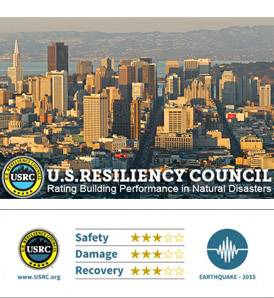SISMICA: U.S. RESILIENCY COUNCIL lancia un sistema di Building Rating
Mentre il sistema di classificazione messo a punto in Italia dal superteam di esperti voluto dall'ex mininistro Lupi riposa sulla scrivania dell'attuale ministro Delrio, negli Stati Uniti la U.S. RESILIENCY COUNCIL lancia un suo sistema di Building Rating.
 Il sistema di rating assegna da una a cinque stelle per tre misure di prestazione: la Sicurezza, il Danno ( i costi di riparazione ) e il Recupero ( il tempo per riguadagnare funzione di base ).
Il sistema di rating assegna da una a cinque stelle per tre misure di prestazione: la Sicurezza, il Danno ( i costi di riparazione ) e il Recupero ( il tempo per riguadagnare funzione di base ).
Questo primo sistema di valutazione delle prestazioni si basa su decenni di ricerca di ingegneria sismica e osservazioni dei danni del terremoto.
Il processo di rating USRC è volontario e viene utilizzato da proprietari di edifici per scopi promozionali, di marketing e di pubblicità .
USRC comprende 64 membri fondatori: le principali organizzazioni professionali dedicate alla sismica e all'ingegneria strutturale, grandi e piccole imprese di ingegneria strutturale molti architetti, imprenditori e fornitori di hardware e software. Ci sono attualmente 63 valutatori certificati e 25 revisori certificati.
Maggiori informazioni sul Consiglio e il suo sistema di rating è disponibile presso www.usrc.org .
Riportiamo qui di seguito (e in allegato) il comunicato stampa della U.S. Resiliency Council
U.S. Resiliency Council
Launches Building Rating System
Rating Building Performance in Earthquakes and Other Natural Disasters
San Francisco, CA, 30th November 2015 – Today the US Resiliency Council (USRC) launched the USRC Earthquake Building Rating System. The Rating System assigns one to five stars for three performance measures—Safety, Damage (repair cost) and Recovery (time to regain basic function). This first-of-its-kind performance rating is based on decades of earthquake engineering research and observations of earthquake damage. ??According to Ron Mayes, Acting Executive Director of USRC, “With the USRC rating system, users will receive reliable and consistent information about a building’s expected performance during an earthquake and be able to use that information for purchasing or leasing decisions on the buildings in which we live, work and invest. The USRC rating system allows an owner to specify the desired level of performance rather than accept by default the life safety performance of a building designed to the minimum level prescribed by the building code. We intend to expand our resiliency ratings to include other natural hazards such as hurricanes, tornadoes and floods in the near future.” ??The USRC process is voluntary. There are two types of ratings. A USRC Verified Rating is used by building owners for promotional, marketing, and publicity purposes. A USRC Transaction Rating is used for transactional due diligence that accommodates both the schedule and cost demands of the leasing, sales, finance and insurance markets for commercial real estate. More information on the Council and its rating system is available at www.usrc.org.
The USRC includes 64 Founding Members made up of the leading professional organizations in earthquake and structural engineering, many large and small structural engineering firms, architects, contractors and hardware and software suppliers. The Council’s mission is to establish and implement meaningful rating systems that describe the performance of buildings during earthquakes and other natural hazard events, to educate the general public to understand these risks, and to thereby improve societal resilience.
Quotes from Prominent Professionals follows:
Dr. Lucile Jones Seismologist with the US Geological Survey and former Science Advisor to Los Angeles Mayor Eric Garcetti. - jones@usgs.gov
Across the Nation, people are making significant financial decisions about buildings often without adequate information about the vulnerability of those buildings to earthquakes. The USRC Rating System is credible, consistent and transparent and would make a better foundation for those critical decisions.
Chris D Poland Consulting Engineer, NIST Disaster Resilience Fellow, Member, National Academy of Engineers - cpoland@cdpce.com
The USRC is poised to fill one of the key missing links needed to create Disaster Resilient Communities. The USRC rating system will provide transparent information on the level of safety and functionality from each rated building; information that reliable mitigation and recovery plans can be based on.
Los Angeles Mayor Eric Garcetti’s November 2014 Report “Resilience by Design” . Contact Marissa Aho - LA City Resilience Officer - marissa.aho@lacity.orgm
As Mayor, I have no greater responsibility than the public safety of Los Angeles. And here in our city, it’s not a question of if the so-called “Big One” will hit. It’s a matter of when. So we cannot afford to be complacent. The known risks – to life, property and our overall economy – are too great. This report recommends a voluntary rating system to encourage building owners to invest in the resilience of their buildings so that they not only stay standing after an earthquake, but so that they also remain functional.”
Greg Michaud - Chairman of the Commercial Real Estate Finance Council and Head of Real Estate Finance, Voya Investment Management - Greg.Michaud@voya.com
Seismic due diligence is very important to the commercial lending and real estate industries. Many in the commercial real estate industry consider the current state of PML reporting to be fractured: lacking consistency, credibility, and professional licensing verification. Just as the accountants created the PCAOB (Public Company Audit Oversight Board) to provide credibility to their members audit reports, I am encouraged that the structural engineering profession is finding ways, such as the USRC, to provide consistency, audit procedures and a revocable certification to those who prepare this critical piece of transactional due diligence”
David A. Friedman, SE, Senior Principal, Emeritus CEO & Chair of the Board - Forell / Elsesser Engineers, - daf@forell.com
I believe in the importance of the US Resiliency Council to provide a long-needed tool for educating the public in understanding and appreciating seismic safety and resiliency in the buildings where we live, work and play.
Thomas Tobin, Tobin and Associates, Public Policy Expertise LTTobin@aol.com
The USRC mission is consistent with my personal philosophy, which is based on the belief that people should be empowered to make informed decisions regarding earthquake safety and performance. People therefore have a right to understand risk—the hazards from, and the vulnerability and expected performance of the buildings they use—and the consequences for their values.
Sorrel Hanson Senior Engineering Specialist with FM Global - Sorrel.Hanson@fmglobal.com
I have observed clients worldwide take on substantial risk due to misconceptions about their buildings’ expected performance in disasters. I believe that consistent and credible ratings are critical to dispel myths and support effective resilience efforts.
Michael Bade Associate Vice Chancellor - Capital Programs at the University of California San Francisco - michael.bade@ucsf.edu
I support the mission and goals of the USRC because I believe it is of great importance to achieve greater public understanding of the nuances of building and infrastructure resiliency in the face of the threat of natural disasters such as earthquakes, storms, and fires. I believe that a more nuanced rating system or systems would aid in achieving this goal.
Dr. Sharyl Rabinovici, Disaster Policy Consultant - sjmr12@yahoo.com
We hope that people come to rely on USRC ratings when they buy a building in the same way that people now rely on 5-star safety ratings when they buy a car. It's a different, more market-based approach than having the government mandate that certain owners do a retrofit.
